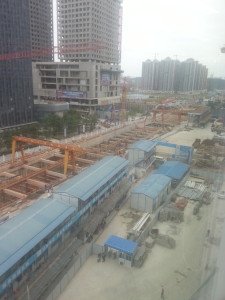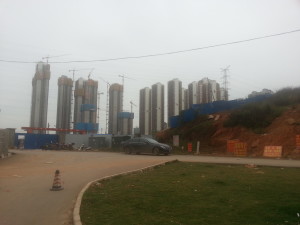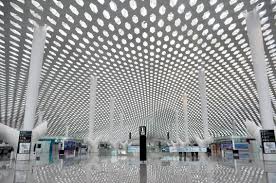We hear problems of overbuild and surplus capacity in China are pronounced in provincial conurbations. I had an opportunity to visit such a locale recently and what I found was a reality at odds with the stereotype and an economy surprising in terms of its dynamism.
Nanning City
In theory Nanning (population 6.9m), being the administrative capital of the Guangxi Zhuang Autonomous Region, should be classified as a Tier II city. In a 2013 ranking though of Chinese cities by GDP it came in at #60. The Guanxi Zhuang Autonomous Region is one of China’s poorer provinces and in a 2015 ranking came in at #17 (of 31). This town then, in reality, is a Tier II.5 city or more fairly a Tier III pocket-metropolis.
Backwater status was confirmed planning for the trip on discovering only one major international hotel in the city and no direct flights from Hong Kong (you need to go via Shenzhen, a little more on that below). A still poorly developed economy was confirmed at breakfast on day one (of the three day visit) by several Caucasian rookie-parent couples nursing new Chinese (I assumed female) family members [Bad China!]. You tend not to see that in Guangzhou much anymore.
The Stereotype
Provincial cites away from the east are believed to lack the economic dynamism of early east-coast trailblazers. A housing/office/infrastructure surplus is soon mopped up in, say, Shanghai because the economic motor turns so much faster there. Shanghai’s Pudong district was labelled a ghost town when development initially got underway but the reality of the area today shows how short-sighted that analysis was.
There are now many examples of developments in Chinese cities, initially dubbed ghost towns, that have outgrown their initial diagnosis (here are just a few http://www.vagabondjourney.com/5-chinese-ghost-cities-came-alive/); but doubters now look to development latecomers for problems. Sure, goes today’s argument, Shanghai, Guangzhou and etcetera have defied pessimists; but there’s only so many cities in China that can develop along those lines. The Johnny-come-lately’s won’t be able to attract the talent, businesses or investment to allow them to follow the East Coast Model.
The Reality
If the synopsis above rings true for you get on a plane to Nanning.
Subway Line 1 is now operational and Line 2 is under construction; Lines 3 through to 8 are planned. An old-new-town is already maxed out and a new-new-town, Wuxiang, is under construction. The airport has a spiffy new terminal and several new bridges across the Yongjiang River are planned and/or under construction.
Overall the general impression, further confirmed through discussions at meetings, is of a city and citizenry for which the Chinese idiom 万马奔腾 could have been precisely tailored (wàn mǎ bēn téng, lit. ten thousand horses galloping).
I went expecting a sleepy and perhaps down-on-its-luck kind of city. I found instead a bustling dynamic. This city may not be in the big league; but it has plans and its population are yanking metaphorical bootstraps hard.
Meet the Pimbys
Discussions in developed cities about infrastructure development, sooner or later, run into a common briar patch; Not In My Back Yard or NIMBY-ism. In the U.K. this has led to a multi-year delay to an expansion of Heathrow Airport. Plans supported by the then government in 2009 may be completed sometime between 2025 and 2030. Closer to home, in Hong Kong, our high speed rail link will run through 26km of tunnels to connect to the mainland. Bored at great cost because the problems of dealing with residents likely to be affected by a much cheaper over ground route were doubtless deemed too daunting?
In China’s less developed cities a different sort of pressure group operates. Whether its developers wanting better transport infrastructure to connect their projects, government recognizing the public welfare benefit of better medical/educational/recreational facilities or just ordinary men and women on the crowded omnibuses. The general wish, when it comes to new facilities, can be summarized thus; Please, In My Back Yard!
The upside of PIMBY-ism (and yes, governments that lean to autocratic decision making) is things are done faster and on a much bigger scale than in places where the population must be consulted on the minutiae of development plans.
The Real Engines of Growth
Opinions are divided on whether capital, productivity, innovation, or investment play the greatest role in fomenting economic growth; but none of these has a bearing if two more important conditions are lacking.
For progress to develop momentum and a business cycle to achieve persistency, businesses, individuals and institutions must be convinced that a hope for a better future is not misplaced and trust their government to deliver the support to help turn hopes into reality.
[As an aside. Is it a lack of hope and trust in governments in the developed West that’s lead to the unhappiness we’ve seen expressed at ballot boxes this year?]
On hope; I talked to a young native whose friend had moved into a new residential development in the new-new-town a little while ago. Wasn’t she living in a desert with poor transport infrastructure and a lot of construction still going on I wondered? Sure, but her friend is happy with the fact that her apartment had cost Rmb7k/sqm and similar were today selling for over Rmb8k/sqm. A subway is under construction in the area and besides, it’s a nice environment while things are still (construction aside) quite quiet.
On trust; at a large commercial project located some way from the city center I again raised the subject of a lack of transportation infrastructure. Not I problem I was assured. Line 8 is planned to run to the doorstep. Line 8, to remind, is the last of the planned lines for a city still pouring concrete on Line 2. The government though has said it will happen and, like my contact, I have no doubt they’ll deliver.
If There Was Any Doubt
20-years ago a Nanninger [Is that right? Ed.] could have been forgiven for wondering if hope was appropriate and trust in government wasn’t misplaced; but today he or she can look at what’s been achieved elsewhere in China; and there can be no doubt, the model is reliable and it works.
China must possess one of the largest groups of accomplished town planners anywhere in the world. What makes them especially effective today is the works they’ve completed, the obstacles they’ve overcome and the variety of locations in which they’ve worked so successfully. A project like Nanning should therefore be a snap.
Perhaps Nanning is 30-years behind Shanghai, or 20-years behind Shenzhen? What’s in no doubt though is where it’s heading; and only the speed and trajectory of its progress is moot.
In Conclusion
Observations from one location, picked almost at random, can’t be used to settle the bigger question of does China have overcapacity problems? Here and there, it almost certainly does.
What this trip brought home to me though was the still tremendous scope for development in the smaller towns and cities.
China must move millions more off the land and if it’s to avoid the problems of over-concentration in Tier I cities it has to make smaller cities viable long term options.
This means they must be economically self-sufficient, offer attractive life-style options and be beacons of opportunity in their respective locations; and this is where Nanning (and goodness knows how many other smaller towns?) is clearly headed.
I look forward to following this plucky city’s energetic progress in future.
_____________________________________________________________
Mementos
Detian Waterfall – 170km or a three hour drive from Nanning City is Asia’s largest waterfall. My picture doesn’t really do it justice but you get the idea. Allow time for lunch. The roadside eateries nearby offer great barbecue selections. I had suckling pig; superb.
Subway Construction – Developing market solution. Dig trench, lay track, cover, repeat. What’s a TBM?
Build it. They’re coming – New construction in the new-new-town. This either frightens or inspires. For me it’s the latter, natch.
Bad China II – This card was conveniently placed in a hotel room that I used on a trip the prior week to Shenzhen and Guangzhou (more fact finding, less interesting). Clearly fed up with complaints from visitors about not being able to get certain services in China the hotel has this card to tell you what you’re not going to be able to access during your stay. Oh dear.
Shenzhen Bao’an Airport – Read what British newspaper The Independent had to say about it a few years ago Bao’an Opens
The article, about it being a shining example of China overbuild, is dated the same day the terminal opened, November 28th 2013. Sure, day-1 what do you expect? Having been through it’s busy halls twice on this trip (and several times before) I confirm it may be very white; but White Elephant it most certainly is not! A shining example, in fact, of another lazy journo fitting facts to a tired anti-China trope.




